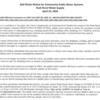Illness and truancy -- how county’s ISDs cope with extended student absences
Cherokee County’s school districts are well aware an ounce of prevention is worth a pound of cure.
Wells ISD canceled classes for two days in early February due to “a sharp spike in absences related to respiratory and flu/flu-like illnesses,” according to a letter posted on the district’s website, dated Feb. 5.
“It is our goal to break the cycle of airborne illness,” WISD interim Superintendent Dale Morton stated in the letter. Classes resumed the following week and the district has not had to cancel classes since.
New Summerfield ISD officials are also keeping a close eye on the situation, as last year the district opted to cancel classes for two days when illness kept a large portion of the student body out of class for several days.
“So far we have been fortunate to have not been hit real hard this year by the flu,” NSISD Superintendent Joe Brennan said on Friday. “We have had some cases, but not near what we had last year when we closed school for a few days. Hopefully a week off for spring break will help get everyone around here healthy!
“We encourage parents to keep their students home if they have fever and not to come back to school until they are 24 hours fever free. Last year’s flu hit our district hard so that is still fresh on the minds of our community -- parents are doing a great job of taking those precautions.
“We monitor student absences during the school year and require make up hours for those students that exceed the number of days allowed by the state. In the event a student was out for an extended period of time due to illness or injury, we would look closely at that and see what could be done.
“We talk to our students all the time about doing the things it takes to stay healthy such as washing hands and covering nose and mouth,” Brennan said. “We also have an amazing custodial staff that keeps our buildings clean and disinfected. We have staff that works during the school day and then staff that works after hours so that they can get into the classrooms and spend time cleaning the rooms while classrooms are empty. Our custodial staff (has been) working during our spring break.”
Fortunately, parents shouldn’t need to worry too much about their school-aged children becoming truant as flu season peaks (and coronavirus concerns grow) since area school districts’ truancy policies only look at unexcused absences.
In Texas, a student could be considered truant after 10 days of unexcused absences. Under a state law enacted last year, Texas schools can no longer send students with three unexcused absences in four weeks to truancy courts. Now school officials notify parents of unauthorized absences and warn them of the consequences.
According to the Texas Education Code, “if a student ages 12 to 18 incurs unexcused absences on 10 or more days or parts of days within a six-month period in the same school year, the district, in most circumstances, will refer the student to truancy court.
“A court of law may also impose penalties against a student’s parent if a school-aged student is deliberately not attending school.”
So what is the process a district takes in helping parents make sure their children are in class?
According to the Student Handbooks of Jacksonville, Bullard and New Summerfield ISDs, “when a student between ages 6 and 19 incurs unexcused absences for three or more days or parts of days within a four-week period, the school will send a notice to the student’s parent, as required by law, to remind the parent that it is the parent’s duty to monitor the student’s attendance and to require the student to come to school. The notice will also inform the parent that the district will initiate truancy prevention measures and request a conference between school administrators and the parent. These measures will include a behavior improvement plan, school-based community service, or referrals to either in-school or out-of-school counseling or other social services. Any other measures considered appropriate by the district will also be initiated.”
“Regular school attendance is essential for a student to make the most of his or her education — to benefit from teacher-led and school activities, to build each day’s learning on the previous day’s, and to grow as an individual,” the handbooks state. “Absences from class may result in serious disruption of a student’s mastery of the instructional materials; therefore, the student and parent should make every effort to avoid unnecessary absences.”
The truancy prevention facilitator for Jacksonville is JISD Police Chief Bill Avera. The truancy prevention facilitator for Bullard is BISD Chief Roy Logan.
Rusk ISD’s handbook categorizes three excused absences per semester based on parent note and outlines the district’s process. School officials will:
• document interventions on the Truancy Prevention Measure form for each student with four or more absences, seven or more absences and nine or more absences;
• hold a conference with the parent of every student receiving a four or more, seven or more, and nine or more letter. If parents do not show to conference the principal will make every effort to conduct the conference via phone. The Behavior Improvement Plan will be completed during the conference. The principal will document violations of the Behavior Improvement Plan on the plan; and
• refer each student with 10 or more unexcused absences to the court system. The Behavior Improvement Plan and Truancy Prevention Measure will be provided to the court.
The district also provides each child whose attendance drops below 90 percent but remains at least at 75 percent of the days the class an opportunity to earn credit or final grade by completing a principal plan, which allows the student to meet the instructional requirements of the class as determined by the principal.
Please support The Cherokeean Herald by subscribing today!
You may also like:






